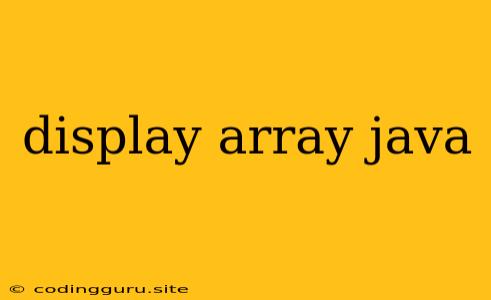Displaying Arrays in Java: A Comprehensive Guide
Java arrays are fundamental data structures used to store collections of elements of the same data type. Understanding how to display the contents of an array is crucial for debugging, analysis, and presentation. This guide will walk you through various methods for effectively displaying arrays in Java.
1. Using a for Loop
The most common and straightforward method is to iterate through the array using a for loop. Here's a basic example:
public class DisplayArray {
public static void main(String[] args) {
int[] numbers = {10, 20, 30, 40, 50};
// Display array elements using a for loop
System.out.println("Array elements:");
for (int i = 0; i < numbers.length; i++) {
System.out.print(numbers[i] + " ");
}
}
}
This code iterates through the numbers array, accessing each element using its index (starting from 0). The output will be:
Array elements:
10 20 30 40 50
2. Using a for-each Loop (Enhanced for Loop)
Java's for-each loop provides a more concise and readable way to iterate through arrays. It automatically handles the index and iterates through each element directly.
public class DisplayArray {
public static void main(String[] args) {
String[] names = {"Alice", "Bob", "Charlie", "David"};
// Display array elements using a for-each loop
System.out.println("Names in the array:");
for (String name : names) {
System.out.print(name + " ");
}
}
}
This code will output:
Names in the array:
Alice Bob Charlie David
3. Using the Arrays.toString() Method
The Arrays.toString() method in Java offers a convenient way to get a string representation of an array, including its elements enclosed in square brackets.
public class DisplayArray {
public static void main(String[] args) {
int[] numbers = {10, 20, 30, 40, 50};
// Display the array using Arrays.toString()
System.out.println("Array elements: " + Arrays.toString(numbers));
}
}
The output will be:
Array elements: [10, 20, 30, 40, 50]
4. Using a Stream
Java 8 introduced streams, providing a functional approach to working with collections. You can use streams to iterate and display array elements:
public class DisplayArray {
public static void main(String[] args) {
String[] names = {"Alice", "Bob", "Charlie", "David"};
// Display array elements using a stream
System.out.println("Names in the array: ");
Arrays.stream(names).forEach(name -> System.out.print(name + " "));
}
}
This code outputs:
Names in the array:
Alice Bob Charlie David
5. Displaying Multidimensional Arrays
For multidimensional arrays (arrays of arrays), you'll need to nest loops to iterate through each dimension.
public class DisplayArray {
public static void main(String[] args) {
int[][] matrix = {{1, 2, 3}, {4, 5, 6}, {7, 8, 9}};
// Display elements of a 2D array
System.out.println("Elements of the matrix:");
for (int i = 0; i < matrix.length; i++) {
for (int j = 0; j < matrix[i].length; j++) {
System.out.print(matrix[i][j] + " ");
}
System.out.println(); // Add a newline after each row
}
}
}
This code will display the matrix elements in a formatted way:
Elements of the matrix:
1 2 3
4 5 6
7 8 9
Choosing the Right Method
The best method for displaying an array depends on your specific needs:
forloop: Simple and efficient for basic iteration.for-eachloop: More concise and readable, particularly for simple operations.Arrays.toString(): Convenient for quick string representations.Stream: Functional approach, useful for complex data processing.
Conclusion
Java provides multiple ways to display the contents of an array. Understanding these methods enables you to effectively debug, analyze, and present your array data, making it easier to work with and understand the information it holds. By mastering these techniques, you'll enhance your ability to leverage the power of arrays in your Java programs.
